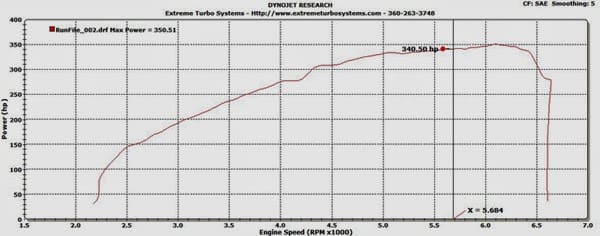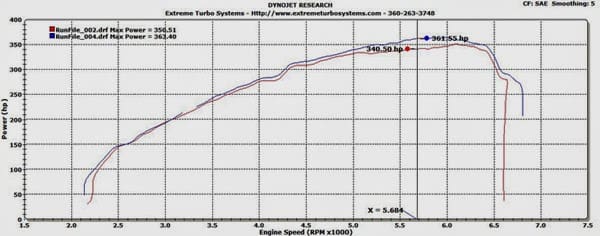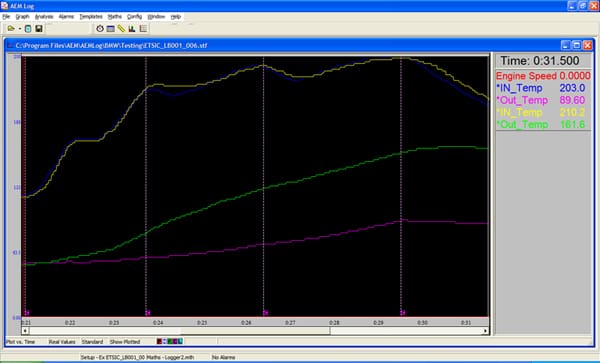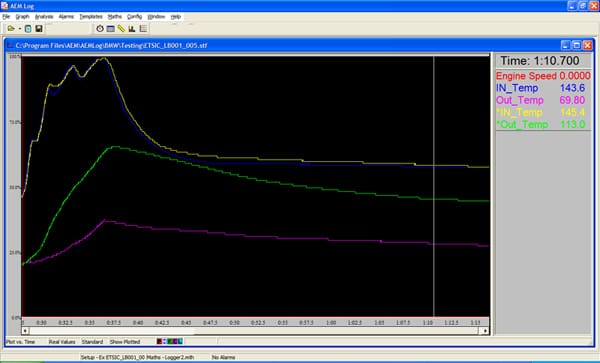

SKU: SKU: ETS-600-10-ICK-038
Earn [points_amount] when you buy this item.
The ETS intercooler Kit Features
Note how the inlet and outlets are staggered. The inlet is at the top of the cooler and the outlet is at the bottom. This design will force the air to flow through the whole cooler, not just straight across as if both inlet and outlets were on the top.

Also note the radiator shroud tabs at the bottom of the cooler.

Analysis of Stock Intercooler,
Base Test on a stage 1 vehicle at 12psi shows good power, but a flat spot in the mid range power between 5000-5700rpm is likely due to the rapidly rising outlet temps of the inefficient stock intercooler. Based upon the 100deg mid pull temps, and the 125deg end of pull temp, there is definitely room for improvement over the stock intercooler.


Analysis of ETS Intercooler,
Upon installation of the ETS Intercooler Kit, the car shows a 21.05hp increase and makes 361 peak hp. Outlet temps are only 59deg at mid pull and the temps only rise to 66deg at the end of the run. These temps are signifigantly lower than stock, and it is no surprise that there is a substancial power increase with the intercooler kit installed. Aside from the midrange, we also noticed a slight Increase in top end power as well. This can be attributed in part to the ETS Replacement Charge Pipe which replaces the plastic stock pipe with the 2 restrictve dimples that protrude into the flow area of the pipe.
Through Gears Test


As our test car was an automatic, it was a perfect candidate for a pull through all 4 gears.This is the test that really shows the difference in the ETS Kit vs. the stock intercooler as this test will put a lot of heat into the system in 1st and 2nd gears, which should show the stock units shortcomings as it gets to the high load areas of 3rd and 4th gear.
In this test we see both intercoolers start out at 50deg, by the top of second gear the ETS intercooler is only up to 57deg, while the stock unit is already at 78deg. By the time we get to the top of third gear, the stock cooler has heat soaked, and the charge temps are up to 124, which is way too hot to safely control knock. While the stock intercooler is struggling in 3rd gear, the ETS intercooler is handling the temps with ease, yielding a 69deg charge air temperature. As the car shifts into 4th, the stock intercooler continues to struggle to control the charge air temps, and fails miserably, ending up at 158deg, and even causing timing to be pulled enough that we see two noticeable dips in power.
The ETS intercooler on the other hand, is handling the load of 4th gear without issue, and is returning good power throughout the rest of the pull. Charge temps rise to only 91deg, and we see a max power difference of 25hp. This is a considerable improvement over the stock unit, and is a difference you can really feel in the drivers seat.

30sec. After Pull Analasys,
The above graph illustrates the how well the ETS intercooler deals with heat even after the pull. As illustrated, the ETS intercooler just never gets hot, and even 30seconds after a run through all the gears, the ETS unit is only 69deg while the stock cooler is still over 110deg. These low after pull temps are important because it means that with the ETS intercooler System you ready to make another pull, while the stock cooler is best left to cool down for at least a few minutes.
Stage 1 Race Gas
After all of the design testing was completed, we ran the car on unleaded MS109 racegas and turned up the torque table settings. The outcome was 393whp and 414tq. Not bad for a stage 1 automatic car, with just intake, intercooler, and a tune.
Free Canadian Standard Shipping on Qualifying Orders over $399*
No fees or duties for Canada
Price Match Guaranteee
Easy Returns Policy
